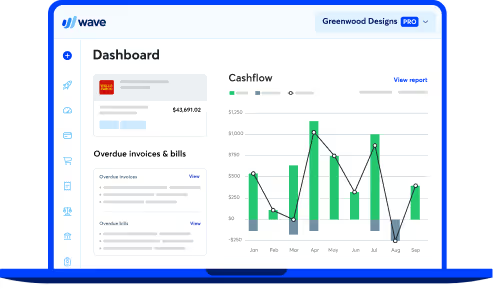
What is the QBI deduction and who qualifies for it?
At Wave, we believe in simplifying how we talk about business and the numbers that go along with it. So, let’s cut right to the chase: What is a Qualified Business Income (QBI) deduction and how do you qualify for it?
A QBI deduction refers to a qualified business income deduction. This tax benefit enables eligible self-employed individuals and small business owners to potentially deduct up to 20% of their qualified business income when filing their taxes.
But there’s lots more where that definition came from. Let’s investigate further.
What’s the Qualified Business Income (QBI) deduction?
Now that we (sort of) know what a Qualified Business Income (QBI) deduction is, we can find out exactly what it means.
First, let’s recap: a QBI deduction is a tax benefit. If you’re eligible, you can deduct up to 20% of qualified business income at tax time. This deduction is only made available to pass-through business owners: that’s sole proprietorships, partnerships, LLCs (limited liability companies) or S corporations.
If you’re a pass-through business who’s opted to take either standard deduction or an itemized deduction at tax time, this QBI deduction still applies to you.
Let’s pause here. Standard or itemized?
Standard tax deductions are a fixed amount that lowers the income you're taxed on. It’s what most people use when they file their taxes.
Itemized deductions are a personalized deduction that varies from one taxpayer to another. It’s calculated by adding up all your relevant deductions and subtracting the total from your taxable income.
Who qualifies for the QBI deduction?
As mentioned above, QBI deductions are only made available to pass-through business owners: sole proprietorships, partnerships, LLCs (limited liability companies) or S corporations.
If your business is what’s called a SSTB (specified service trade or business), like a law firm or medical clinic that relies on the reputation and skill of yourself or staff, the QBI deduction might be restricted or even eliminated. This would be the case if your total taxable income goes over a specified threshold. It also applies if standard deduction is chosen over itemizing.
Okay, this is getting heavy. Let’s a take moment to break this down with a few definitions:
What is qualified business income?
Qualified business income means the net amount of your business’s income, except for investment income (like capital gains or losses, or dividends); income from any businesses that are located outside of the US; and interest income that cannot be correctly assigned to a specific trade or business. Here’s a full list of exceptions from the IRS.
What is a pass-through business?
A pass-through business is a type of business where the profits and losses "pass through" to the owners' individual tax returns. This means the business itself isn’t taxed at the “entity level.” Businesses like sole proprietorships, partnerships, limited liability companies (LLCs), and S corporations are considered pass-through businesses, but not C corporations—they’re taxed separately from their owners.
What is a Specified Service Trade or Business (SSTB)?
A SSTB is a specified service trade or business. Essentially, it’s a type of business that offers services where the reputation or skill of either the employer or the employees are the main asset. Think health, law, accounting, consulting, financial services, investing, etc.
How does the QBI deduction work?
Is your business a SSTB? What if it isn’t? Let’s break down how the QBI deduction works for both, and what taxable income refers to.
QBI deductions for SSTB’s
If you’re an SSTB, you’ll either get the full 20% deduction, a limited deduction, or no deduction at all based on your total taxable income.
So, what’s total taxable income? This refers to your income before the QBI deduction happens. This could include any wages from other jobs, money earned from your spouse, and things like interest and dividends, capital gains, and even rental income.
Most taxpayers will see this as “adjusted gross income” which is noted on Form 1040.
If you don’t have a specified service trade or business
If your business doesn't fall under the category of SSTB, but you have taxable income exceeding $220,050 for a single filer or $440,100 for joint filers, your QBI deduction will be restricted to the higher of:
- 50% of your share of the W-2 wages paid out in your business, or
- 25% of your share of the W-2 wages paid out in your business, plus 2.5% of qualified property
Okay, let’s break out those dictionaries again.
What is qualified property? A qualified property refers to any tangible, depreciable asset that has not yet reached the conclusion of its depreciable lifespan. In most cases, that’s 10 years, but for real estate, the lifespan can extend up to 39 years.
Now, back to limits. Let’s take a look at taxable income limits for the recent tax year.
Taxable income limits for 2023:
An addition to the Qualified Business Income deduction
For both SSTBs and non-SSTBs, a secondary deduction worth up to 20% of the following income can be added to your QBI under two circumstances:
- If the business owner has dividends from a qualified real estate investment trust (REIT or qualified REIT dividends), or
- The business owner has publicly traded partnership income for the same tax year.
To figure out the claim, first calculate the two deductions, then add them together. Once you have that number, calculate your overall limitation (see the chart above) by taking 20% of your taxable income for the year (prior to your QBI claim) minus net capital gain. This includes qualified dividend income which is taxed at capital gains rates.
Wondering what the limitation is for? It’s there to make sure that the 20% claim isn’t taken against income that’s already been taxed at the lower capital gains tax rate.
How to calculate the Qualified Business Income (QBI) deduction
Calculating your QBI can be a complex process. Even figuring out if you’re eligible for it can be tough. To help, follow these step-by-step instructions.
Step 1: Are you a SSTB?
If you need help answering this, check out the IRS and their Qualified Business Income FAQs.
Step 2: What’s your total taxable for the year?
Once you find that out, measure it against limits. If it’s less than $170,050 for a single filer or $340,100 if married and filing jointly, you can take the full 20% QBI deduction—no matter what type of business you operate.
Step 3: Know your limits, especially if you’re an SSTB.
Have you determined that you’re an SSTB? If yes, then you and your total taxable income is $220,050 or higher ($440,100 or higher for married couples filing jointly), don’t go any further. 🛑 You’ve made too much to claim the deduction.
Not an SSTB? You can claim the full 20% if your total taxable income is between $170,050 and $220,050 (or $340,100 and $440,100 if you’re married and filing jointly).
If you are an SSTB and your total taxable income is between $170,050 and $220,050 (or $340,100 and $440,100 if you’re married and filing jointly), move on to step 4.
Step 4: The calculation for SSTBs.
If you’re considered an SSTB and have an income in the phase-out range, you’ll find your deduction by taking 20% of your qualified business income and applying the limitation of either:
- 50% of your share of W-2 wages that have been paid by your business, or
- 25%of those wages, plus an extra 2.5% of your share of qualified property
You’ll then compare these numbers to 20% of your QBI, then deduct the smaller amount of the two.
QBI deduction calculation: An example
Math’s always easier with real-life examples, don’t ya think? We do, so let’s bring the marvelous Margot into the picture.
Margot is a registered massage therapist who’s got $15,000 in qualified property. Margot is single, and likes long walks on the beach. But because this isn’t a dating profile, we just need to know that she's filing solo and as a SSTB.
Let’s look at a few scenarios to understand QBI limits.
- Due to people working in ergonomically-correct positions, Margot had a slower-than-average year as an RMT. As such, her total taxable income was less than $340,100. This means her deduction won’t be limited.
- Margot’s magical hands went viral and her business boomed! Her total taxable income was more than $340,100 but less than $440,100. This means her deduction is limited.
- Margot got hired by a celebrity who’s name rhymes with Pwyneth Galtrow. She now makes more $440,100 a year, which means no deduction is available.
Need a worksheet to work this out? The IRS has you covered. Check Form 1040 for iInstructions and IRS Publication 535 to help you figure out your own deduction. If your taxable income pre-QBI deduction is less than $170,050 ($340,100 if you’re married and filing jointly), use the worksheet in the Form 1040 instructions. If it’s higher, use the Publication 535 worksheet.
Still have questions about the QBI deduction?
Don’t worry, we won’t take it personally.
The truth is, QBI deductions tend to come with a lot of WTFs. It’s a complicated topic to break down and apply to your business, and the process of calculating your deduction (if you get one) can be tough to figure out.
Fortunately, Wave can help. Not only are those daunting calculations made easier with accounting software that keeps you and your income totals up-to-date, but our Wave Advisors have been known to be QBI pros. They’re here to answer your questions around this complex topic, and help you understand whether or not you apply for the deduction, if you’re an SSTB or not, your limits, and how to do the math.
So, go ahead. Hit us up with your FAQs about QBIs. We promise we’ll come back with the 411 (and without any more acronyms).
(and create unique links with checkouts)
*While subscribed to Wave’s Pro Plan, get 2.9% + $0 (Visa, Mastercard, Discover) and 3.4% + $0 (Amex) per transaction for the first 10 transactions of each month of your subscription, then 2.9% + $0.60 (Visa, Mastercard, Discover) and 3.4% + $0.60 (Amex) per transaction. Discover processing is only available to US customers. See full terms and conditions for the US and Canada. See Wave’s Terms of Service for more information.
The information and tips shared on this blog are meant to be used as learning and personal development tools as you launch, run and grow your business. While a good place to start, these articles should not take the place of personalized advice from professionals. As our lawyers would say: “All content on Wave’s blog is intended for informational purposes only. It should not be considered legal or financial advice.” Additionally, Wave is the legal copyright holder of all materials on the blog, and others cannot re-use or publish it without our written consent.


























